Last week, Jason Price examined the ‘Naryshkin, Antoncich’ Bergonzi violin, one of the instruments in the collection of Antonio Antoncich. This week, he looks at another exceptional instrument once owned by Antoncich: the ‘Primrose, Lord Harrington’ Guarneri viola.
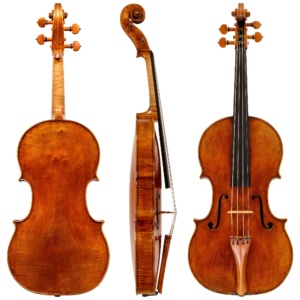
There are roughly half a dozen surviving Guarneri violas, and the ‘Primrose’, dated 1697, the year before Andrea’s death, is the last. Although the original label is of Andrea, the workmanship revealed in its details and broader concepts is the hand of his son, Giuseppe Guarneri ‘filius Andrea’. It is made on the smaller ‘contralto’ model, which ultimately replaced the larger, more unwieldy ‘tenore’ violas favored by makers such as Andrea Amati, Gasparo ‘da Salo’ and Maggini.
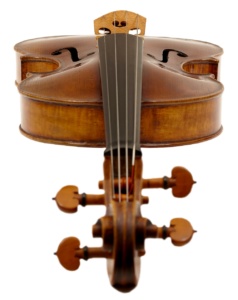
With its shorter back length (41.3 cm compared to the giant 47.0 cm of some ‘tenores’), the Guarneri ‘contralto’ model has been a favorite of players and makers for over three centuries. This is all the more surprising considering how few Guarneri violas there are in existence.
In March 1925 the Hills wrote that they knew of only three violas by Andrea Guarneri.[1] From provenance we can work out these to be the ‘Conte Vitale’, the ‘Imai’ and the ‘Primrose, Lord Harrington’. By the time they published their seminal study of the Guarneri family in 1931, they knew of four.[2] Today we can raise that number to seven.[3] There remains another unaccounted for Guarneri viola – a reduced tenore, which Count Cozio notes in 1816 that he purchased from Professor Pietro Bertuzzi.[4] Cozio’s description of that viola doesn’t seem to match any of the seven we know about, so perhaps someday this instrument too will be rediscovered.
Cozio’s description of that viola doesn’t seem to match any of the seven we know about, so perhaps someday this instrument too will be rediscovered
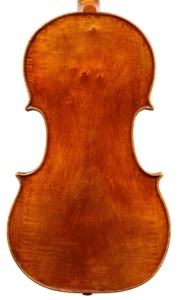
The back is made from a rather humble tree: slab-cut maple with wings in all four bouts and a cluster of knots in the upper center bout.
The back of this great viola is made from a rather humble tree: one piece of slab-cut maple with wings in all four bouts and a small cluster of knots in the upper center bout. The top is in two matched pieces of spruce with rather wide grain at the bouts. The edgework at the top and back is careful but not fussy and lies somewhere between what one expects of Andrea – longer corners, a finer edge – and what one sees in more mature violins by Giuseppe ‘filius Andrea’, that is the shorter corners, broader edges and shallower channelling.
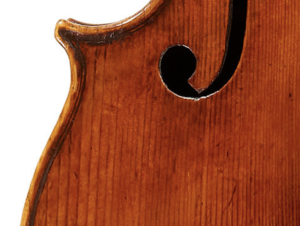
The edgework is careful but not fussy and lies somewhere between what one expects of Andrea – longer corners, a finer edge – and what one sees in more mature violins by Giuseppe ‘filius Andrea’ – shorter corners, broader edges and less depth in the channelling.
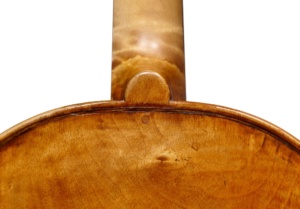
Two large maple locating pins are set just inside the purfling of the back.
The arching of both back and top is rounded in the centre and slightly hollowed just inside the corners. On the top, the hollowing above the f-holes is exaggerated and slightly ‘pinched’ as one sees in later ‘filius Andrea’ violins. Two large maple locating pins are set just inside the purfling of the back. The internal centre pin appears to be of the same stock.
The sound holes show the unmistakable hand of Giuseppe ‘filius Andrea’: they are upright, narrow and straight without being stiff. The upper and lower holes are round, and the wings are slightly pinched.
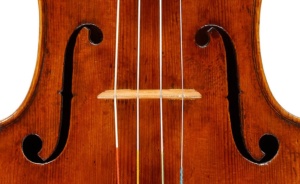
The sound holes show the unmistakable hand of Giuseppe ‘filius Andrea’: they are upright, narrow and straight without being stiff.
The head is superbly carved and sculpturally elegant. The pegbox is robust and sturdy, almost to the point of being massive, yet the volute reduces elegantly to a fine and almost diminutive eye. Compass points are visible along the central ridge of the back and at the heel of the pegbox. As with most Cremonese violas, the ‘Primrose’ has a stepped pegbox at the neck’s transition which allows for a wider interior and balances the longer and larger head. The step here, however, has been reduced by way of a clever neck-graft which is more comfortable for the player in the first position.
The head is superbly carved and sculpturally elegant
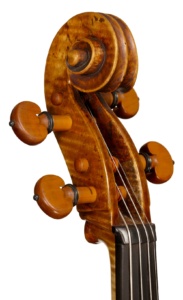
The head is superbly carved and sculpturally elegant.
The label of the ‘Primrose’ is original and, excluding the faded last digit, is in excellent condition. But this obscured final number has made the precise dating of this viola the subject of some debate. Initially, the Hills and Wurlitzer refer to the date in their correspondence and certificates as 1694, but the later Hill Guarneri book (published after this exchange) dates it to 1697. Robert Bein agreed with the later date, and used the 1697 date in his monograph on the viola, which was published in 1983. Under ultraviolet light the last two digits of the label do indeed appear to be 9-7, which makes sense given Giuseppe’s obvious handiwork and the fact that Andrea died a year later, in 1698.
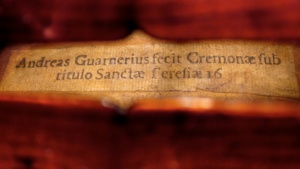
Under ultraviolet light the last two digits of the label do indeed appear to be 9-7, which makes sense given the obvious hand of Giuseppe and the fact that Andrea died a year later, in 1698.
The varnish of this viola is rich in both color and texture and covers the instrument generously on top, back, ribs and head.
The history of the ‘Primrose, Lord Harrington’ Guarneri viola
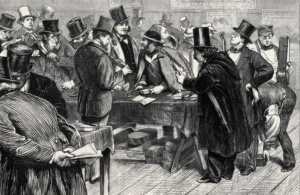
Viewing the Gillott auction at Christies in April 1872.
From the time it left the Guarneri workshop until the mid-19th century, the whereabouts of the Primrose are unknown. At some point during the 1800s, Joseph Gillott (1799 – 1872), a wealthy industrialist from Birmingham who made his fortune producing nibs for fountain pens, acquired the viola. Gillott was a self-made man who, by the time of his death, had amassed one of England’s most important collections of musical instruments. Most of these were acquired from either Luigi Tarisio, George Hart or Charles Reade.
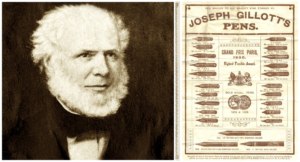
Joseph Gillott (left) and an advertisement for his pen nibs.
Upon his death, Gillott’s collection of art and musical instruments was disbursed at an important seven-day auction at Christies. The first six days of the sale were dedicated to his art collection, and the seventh, April 29, 1872, was devoted to his collection of musical instruments. The 153 lots of exceptional instruments included the 1715 ‘Emperor’ Stradivari, the 1732 ‘Gillott, Dunmore’ Guarneri ‘del Gesù’ and two violas by Stradivari, the 1672 ‘Mahler’ and the 1734 ‘Gibson’. At the sale, this Guarneri viola was purchased by Charles Windham Stanhope, the 7th Earl of Harrington (1809 – 1881) on the advice of William E. Hill for £60. The other instruments in Lord Harrington’s collection included the 1744 ‘Prince of Orange’ Guarneri, the ‘Pagannini’ Stradivari of 1724 and a gamba by Jacob Stainer.
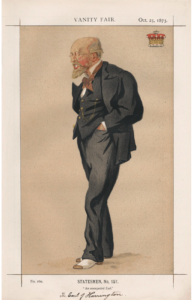
Lord Harrington, in an illustration in Vanity Fair, one year after he purchased the ‘Primrose, Lord Harrington’ viola.
Lord Harrington passed away in 1881 but his collection remained in the Stanhope ancestral home, Elvaston Castle in Derbyshire. The 8th Earl of Harrington (1859 – 1928), however, didn’t share his father’s appreciation for musical instruments. In 1892, a Derbyshire maker reported to Alfred Hill that the viola was slightly damaged when the 8th Earl left it in front of the fire and fell asleep. In 1920 Lord Harrington put this viola to auction at Puttick & Simpson where it was purchased by the Hill firm for £150. In 1925 the Hills sold it to Antonio Antoncich (1868 – 1955). Three decades later the viola found its way to New York City where Rembert Wurlitzer sold it to William Primrose (1904 – 1982) in 1955. Primrose played the viola for much of the last half of his career, which he spent between Australia, Japan and America.
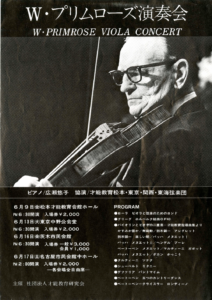
William Primrose with the ‘Priomrose, Lord Harrington’ from a Japanese concert promotional poster.
In 1975 Primrose sold the viola through Benjamin Koodlach in Los Angeles to Gary Vanosdale, a violist then living in Nashville. Three years later, Bein & Fushi sold the viola to Ulrich Fritze, a violist in the Berlin Philharmonic. Fritze played the viola in the Philharmonic for over thirty-five years. In 2012 it was sold by Tarisio in a private auction for a record sum to its current owner.
Jason Price is Tarisio’s Founder, Expert, and Director.
Notes
[1] Letter from W. E. Hill & Sons to Antonio Antoncich, March 6, 1925, unpublished.
[2] William Henry Hill et al., The Violin Makers of the Guarneri Family (1626-1762), (London: Dover Publications, 1931, 1989), 13.
[3] We’ll exclude from this list the cornerless tenor violas d’amore by Pietro of Mantua.
[4] Count Cozio di Salabue, ‘Carteggio’, October 13, 1816.